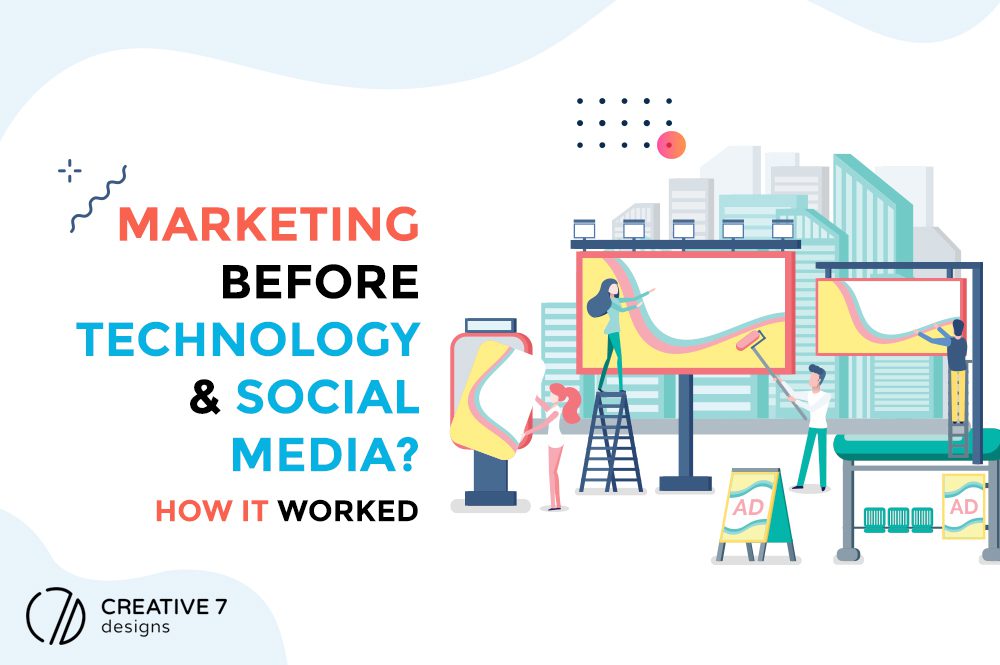Overview: Learn what marketing techniques people and businesses used to experience success before technology.
These days we have emails, text messages, sponsors, banner ads, and more. It’s literally become easy to receive information at the tip of our fingers thanks to technology. All it takes is one click, and we’ve got ourselves anything and everything we need to live. So, how’d they do it?
How did the businesses and people before this tech era market themselves successfully before technology?
Back in the day, marketing relied heavily on understanding psychology and creativity, according to an article published on CoVaBiz Mag. It still relies on these things today, but in a different way.
This isn’t about modern marketing, though. Let’s take it back a bit — as in take it back to the mid-19th century. Then we’ll make our way up to our current world of marketing to see if we share any similarities, or have simply created our own lane of marketing techniques that those back in the day simply can’t fathom.
A CRASH COURSE ON MARKETING DATING BACK TO 4000 BCE:
Before technological advancements and digitization, there were humble beginnings where marketers and business owners simply tried to win customers’ trust and sell goods.
Egyptians used papyrus to make sales messages and wall posters. Commercial messages and political campaign displays have even been found in the ruins of Pompeii and Arabia.
Lost & Found advertising on papyrus was common in Ancient Greece and Ancient Rome, as well.
Wall or rock painting for commercial advertising is another manifestation of an ancient advertising form, which is present to this day in many parts of Asia, Africa, and South America. The tradition of wall painting can be traced back to Indian rock art paintings that date back to 4000 BCE.
This information can be found in the article: Advertising in Rural India: Language, Marketing Communication and Consumerism.
However, with the present fourth industrial revolution paving the way, marketing agencies have been forced to keep up with leaps in technology, resulting in many opting for modern approach to selling instead of manual advertisements and brochures.
There’s been a drastic change in marketing with a shift from print media to electronic and social media. With consumers spending more time on their smartphones and laptops, several new platforms are introduced to benefit consumers and sellers alike.
Everything changes with time, and when the digital landscape evolved, emails stepped in — with them, Yahoo (1994) and Google (1997). Things weren’t much advanced even after introducing the search engine, (i.e., Google) but when Amazon (1994) and eBay (1997) started emerging as the most significant eCommerce websites, this practice became a goldmine for marketing.
Email became a new marketing tool while the search engines cataloged websites that allowed users to gather information, services, and products of their needs.
Marketers used early ranking techniques like keyword stuffing and backlinks to generate views and drive the audience to their websites. With digital marketing, the local community’s stores at the end of your alley are now widely known since the distance is no longer an issue now.
The Birth of Websites:
A research report states that 81% of retail shoppers conduct online research before purchasing. If your business doesn’t have a website, you must have command over magical words to flatter your customers. With men and women excelling in their concerned fields, none has time to stroll down the local stores and search for the perfect product.
Now it’s the era of search engines, e-commerce, and eye-catchy websites.
One of the frequent ways that users opt to conduct their preliminary research is by checking reviews. Having an account set up on Googly MyBusiness and TripAdvisor encourage happy customers/consumers is a great way to boost your sales and escalates the chance of enticing a potential buyer. With digitization, we notice that 61% of people read reviews before buying a product.
The Websites Replace Traditional Media:
It’s exciting to see how websites have impacted traditional market strategies across the globe. Websites have become the front door for businesses, and the rightly designed websites either welcome customers warmly or send them away.
If you’re considering traditional media outlets, consider how websites enhance your brand image. Having access to literally millions of web pages, users find it hard to trust an existing/ emerging business that doesn’t have support for a website.
Suppose you’re advertising your product with a great television ad or hot radio spot (people don’t listen to the radio anymore, or at least don’t follow it anymore). In that case, they won’t rely solely on recommendations or aren’t going to construct their opinion of your company. Instead, they’ll look for validation and confirmation – users will be curious to see what you have in store. If they search your brand name and don’t find anything, you might just lose a valuable customer.
ECOMMERCE VS IN-STORE SHOPPING:
18th and 19th-century entrepreneurs are delighted at the E-Commerce opportunities offered by digital marketing. Business owners don’t invest in a brick-and-mortar shopping store to sell their products – instead, they sell everything on a designed website through E-Commerce.
The best thing about E-Commerce is it doesn’t have geographical chains or limitations, and anyone from any corner of the world can buy anything from the store without waiting in line or getting out of bed. However, this ease is followed by the death of physical establishments for the store owners.
Social Media Marketing Has Transformed Traditional Marketing:
Before the advancement of the internet, businesses used to invest a lot of money in designing brochures, advertisements, and promotions to boost their businesses.
Traditional methods, including printing posters, designing, and banners, were used to draw customers’ attention to the matter. The cost wasn’t cheap either, but social media marketing has replaced the traditional goals – and the truth is told- it has made promotions way easier for less money and far-reaching audiences.
Increased Competition in the Marketing:
While technology has opened many doors for marketers to reach a broad audience, it also presents challenges you’ll most likely encounter. Since everyone has access to the internet and it’s easy to send your words out, it’s becoming challenging for marketers to get their stuff noticed. There’s a great competition for you, from popping ads on a website to a long 60-secs ad on the most-viewed video on Youtube.
Generating traffic and leads requires professional hands since everything is available at the click of a button.
In Summary:
So far, technology has impacted marketers more positively than negatively. Online ads reach far and bring a broad audience than traditional marketing, yet, traditional media is still integrated as a doorway to enhance your business and online presence.


